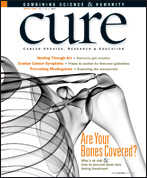Publication
Article
CURE
Art & Life
Author(s):
A program in New York City helps survivors use artistic expression to communicate their experiences.
Sheiliah Giles recalls the days in the late 1960s when she was a street artist doing portraits in Greenwich Village to make a living. For Giles, a “pk” or preacher’s kid, music and the arts have been an integral part of her life from early childhood. “Being creative brings me close to the creator,” she says. Professionally, it was commercial art that paid the bills, but it was fine art Giles turned to for inner satisfaction.
Then in 1993, at the age of 43, her life came to a stop with a diagnosis of breast cancer. The physical and mental pain left her immobilized, unable to work, and unable to create art or enjoy music.
Giles “found her voice” again a few years after treatment when she was introduced to The Creative Center: Arts in Healthcare, where artists taught classes in a variety of areas for those who had cancer or other chronic illnesses. Because all the classes were free, Giles, by now on disability, became an active participant, finding again the healing elements of the arts that “saved her emotionally, spiritually, and physically.”
Then in 1999, Giles suffered a stroke.
“The stroke altered how I perceived art. I could no longer create fine art because it wouldn’t naturally flow,” she says. Not willing to give up art, she chose other classes at the center, including printmaking and quilting. She discovered creating in any form helped diminish her chronic pain and reconnect her to the power of creative immersion.
Giles was one of 25 participants in a 2005 photography class at The Creative Center that produced Still Life: Documenting Cancer Survivorship, a book of photos and essays documenting the lives of cancer survivors. A grant from the Lance Armstrong Foundation funded the workshop and paid for digital cameras for the participants, who were chosen through a lottery because of the large number who wanted to take part.
It was hard to listen to people going through the early stages. But the classes weren’t about health issues—they were about doing the work. The exploration was amazing.
The workshop participants came together with Artist-in-Residence Karen Furth, a professional documentary photographer, who guided the class while they explored their lives through the lens of a camera. At the end of the class, the portfolios were juried by other professional artists who chose which images would go in the book.
“Karen wanted it to be documentary, and I said, ‘Well, I have this camera. How can I document myself and be in the photo myself?’ ” says Giles, who tried taking pictures of herself but wasn’t satisfied with the result. She decided instead to photograph her world from her own view: pill bottles everywhere and other reflections of what she sees every day.
Jayne Mangino, also part of the Still Life project, says the class members represented all stages of cancer survivorship, and, while cancer was not the focus of the class, it came up as the group melded while projecting their work on the wall for discussion.
Mangino says it was hard to listen to people going through the early stages of dealing with cancer. “But the classes weren’t about health issues—they were about doing the work. The exploration was amazing.”
Like Giles, Mangino has been an active participant at the center for a number of years. On disability since 1986 while in and out of treatment for stage 4 lymphoma, Mangino, 57, a former public relations professional, considered photography her avocation, but was afraid to exhibit her work until she was diagnosed with cancer. She wanted to expand her skill after her diagnosis but couldn’t sustain the energy needed for a college class, she says. The center provided the perfect option, with classes meeting once a week for three to five weeks.
Because the group bonded so strongly, the class rebelled after seeing the first design of the book that would have represented only 10 of the artists. They decided some artists would have more than one photograph in the book, but everyone would have at least one page.
“I don’t consider this being a book about cancer, but a book about living,” Mangino says. “It’s about how we live.”
For Len Leone, 57, taking part in the Still Life project allowed the quiet painter to see he was not alone in his feelings after undergoing 40 radiation treatments for an unknown primary in 2000 that manifested as squamous cell carcinoma.
“The classes brought back lots of memories and I revisited lots of unpleasant memories,” he says. “But it was really good for me because I met lots of other people who had cancer who talked about their fears. I thought I was the only one who felt that way.”
Leone became involved in The Creative Center in 2005 when he went to one of the center’s art openings and met executive director Robin Glazer. He took part in the lottery and was chosen for the class.
“We really supported each other,” he says. “The meetings to review the pictures became like support groups.” Leone used shattered mirror for his self-portraits because he says when you hear the word “cancer” you come apart. And I wanted to have hope, which is why I formed the pieces into a flower. And that’s the title of it: “Shattered Life with Hope.”
While working with AIR Karen Furth, the students took photographs, attended lectures at New York City museums, and met to display and discuss their photos. Each student took a different approach to self-documentation.
Still Life, published in 2006, can be ordered on The Creative Center’s website at www.thecreativecenter.org. New photos from Sheiliah Giles and Jayne Mangino can be seen as part of the latest photography project, The Four Seasons: Documenting a Year (www.thecreativecenterarts.org).






